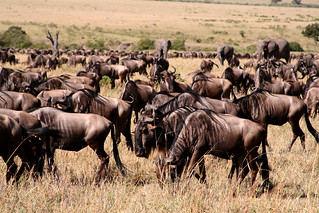Great Wildebeest Migration Safari | Serengeti & Maasai Mara
The Great Wildebeest Migration safari is one of the most breathtaking natural spectacles on the planet. Every year, more than 1.5 million wildebeest, along with hundreds of thousands of zebras and gazelles, journey across the Serengeti–Maasai Mara ecosystem. This continuous movement, driven by the search for fresh grass and water, has made the migration one of the Seven Natural Wonders of Africa and a dream for safari travellers’ worldwide.
If you’ve ever wondered when and where to see the great wildebeest migration safari , this guide covers the cycle, highlights, and tips for planning your trip.
What Is the Great Wildebeest Migration?
The migration is not a single event but a year-round cycle of survival. As the seasons change, massive herds move through the Serengeti in Tanzania and cross into the Maasai Mara in Kenya. Along the way, they face predators, crocodile-infested rivers, and the challenges of the African wilderness.
For travellers’, the Great Migration offers a chance to witness not only wildebeest herds but also dramatic predator-prey interactions, making it the ultimate safari experience.
The Migration Cycle – Month by Month
January – March: Calving in the Southern Serengeti
The year begins in the Ndutu region of the southern Serengeti, where wildebeest gather to give birth. Nearly 500,000 calves are born within a few weeks. This period is spectacular for wildlife photography, as predators like lions, cheetahs, and hyenas patrol the plains in search of vulnerable young calves.
April – May: Moving North
As the grasslands dry out, the herds begin moving north through the central Serengeti. Large columns of wildebeest and zebras can stretch for miles, creating a true safari spectacle.
June – July: The Grumeti River Crossing
By June, the wildebeest reach the Grumeti River, the first major obstacle of the migration. Nile crocodiles wait patiently, and the crossings here are dramatic but less crowded than those at the Mara.
July – October: The Mara River Crossing in Kenya
This is the most iconic stage of the migration. Herds surge into Kenya’s Maasai Mara National Reserve, crossing the Mara River in massive numbers. With crocodiles below and predators on the banks, it’s a heart-pounding moment that defines the Serengeti Maasai Mara migration tours.
November – December: Returning South
When the rains return to Tanzania, the herds begin their long trek back to the southern Serengeti, completing the cycle and preparing for another calving season.
Best Time to See Wildebeest Migration
The best time to see wildebeest migration depends on what you want to witness:
Calving season (January–March): Best for newborn calves and predator action.
River crossings (June–October): Ideal for dramatic scenes at the Grumeti and Mara rivers.
Return migration (November–December): Fewer crowds, but excellent game viewing.
Where to See the Migration
Serengeti National Park (Tanzania): The core of the migration and home to the calving season.
Grumeti Game Reserve (Tanzania): Famous for river crossings in June and quieter safari experiences.
Maasai Mara National Reserve (Kenya): Known for the legendary Mara River crossings between July and October.
Many traveler’s combine both Tanzania and Kenya in their itineraries to maximize their chances of seeing different stages of the migration.
Why Choose a Great Wildebeest Migration Safari?
Witness one of nature’s greatest spectacles.
Experience predator-prey interactions rarely seen elsewhere.
Visit two of Africa’s most iconic safari destinations: the Serengeti and Maasai Mara.
Support conservation and local communities through eco-tourism.
Tips for Planning Your Migration Safari
Book Early: Lodges and camps near migration hotspots fill up quickly.
Choose the Right Time: Decide if you prefer calving season or river crossings.
Go with Experts: Guided Serengeti Maasai Mara migration tours ensure you’re in the right place at the right time.
Pack Smart: Bring good binoculars, a camera with zoom, neutral-coloured clothing, and sun protection.
Facts on the Great Wildebeest Migration Safari
The Great Wildebeest Migration safari is the ultimate African wildlife adventure. From the dramatic Mara River crossings to the heartwarming calving season in the Serengeti, each stage of the migration offers something unique.
Knowing the best time to see wildebeest migration and planning a safari that follows the herds will give you front-row seats to one of the world’s most remarkable natural events. Whether you choose Tanzania, Kenya, or both, Serengeti Maasai Mara migration tours promise an unforgettable safari experience.



Comment (0)